Graptopetalum (Graptopetalum) either spotted - this genus is directly related to the Crassulaceae family. It unites about 20 plant species, which are represented by succulents. In natural conditions, they can be found in the arid regions of the American continent, from Arizona (USA) to Mexico.
In this genus, there are species whose height is no more than 5 centimeters, and there are also those that reach almost a meter. In addition to size, species also differ in the nature of growth. So, they can be branched shrubs with succulent shoots or stemless. However, all species have a rounded dense leaf rosette, apical or ground. In some species, the leaves are squat, while in others, they look like disheveled cedar cones.
On the lateral axillary peduncles there are branched few-flowered inflorescences in the shape of a brush. Separate star-shaped flowers have a wide-open calyx with 5–7 lanceolate petals, as well as with long stamens, of which there are from 10 to 15 pieces. The plant blooms from May to July for several weeks.
Caring for graptopetalum at home
Graptopetalum is well suited for indoor cultivation. It is unpretentious and undemanding to care for. Such a plant can decorate a room both alone and in a "campaign" with other succulents. And all because he quite easily gets along with many neighbors.
Illumination
Lighting is necessary bright and at the same time the plant is quite calm about the direct rays of the sun. When choosing a place for such a flower, it is recommended to give preference to southeast as well as south orientation windows. However, beautiful graptopetalum can easily grow on the windowsill of the western window.
If the light is too little, then it is recommended to supplement the plant using special phytolamps. When using additional lighting, you should maintain a day length of about 10 hours.
Temperature regime
In summer, the plant grows and develops best at temperatures between 25 and 28 degrees. From the beginning of autumn, the temperature must be reduced, and from mid-November to the end of February, this succulent has a dormant period. For this period, it should be rearranged to a cooler (from 6 to 12 degrees) and bright place (for example, a warmed balcony, loggia).
How to water
During intensive growth, watering should be moderate. Liquid should not be allowed to stagnate in the soil. Watering is necessary only after the soil dries out to a depth of ½ part. You need to water it with water at room temperature, which must be well settled before that.
During cold wintering, watering should be very sparse. It must be done, paying attention to the turgor of the sheet plates. As a rule, this procedure is sufficient to perform only once every 4 weeks.
Air humidity
Feels comfortable with low air humidity in city apartments.
Earth mix
Almost any loose soil mixtures are suitable for such a plant, which are easily permeable to water and air, and are also poorly nutritious. There are several types of soil mixtures:
- rough coniferous and leafy soil, peat, coarse sand (2: 2: 1: 3);
- sod and leafy land, coarse river sand (1: 1: 1);
- coarse sand, sod land (1: 1);
- purchased ready-to-use mixture for succulents and cacti, small brick chips, river sand (3: 0.5: 1).
It is best to plant in low, wide containers, because such a plant does not have a developed root system. Don't forget to make a good drainage layer at the bottom of the pot, which will help prevent liquid stagnation in the soil. After planting, small pebbles can be laid out on the surface of the soil, which will help prevent juicy leaves from contacting the moist soil.
Fertilizer
During active growth, top dressing should be carried out once every 4 weeks. To do this, use a special fertilizer for succulents and cacti. From the beginning of autumn to mid-spring, it is prohibited to apply fertilizers to the soil.
Transplant features
Transplanting the plant is necessary only if absolutely necessary. For example, when the roots no longer fit in the pot.
Reproduction methods
It can be propagated by seeds, leafy cuttings and easily rooted daughter rosettes.
Before planting leafy cuttings, they must be dried for 24–48 hours. Then their petiole is buried in the soil mixture. Such cuttings should not be very moistened or covered with glass or film, because rot can appear on them very quickly. If optimal conditions are created, then rooting will occur after 7 days, and after 6-8 weeks the formation of a young plant will begin.
Diseases and pests
Practically not susceptible to pests, as there is a wax coating on the foliage surface. Most often, the plant suffers from a variety of rot, which are caused by violation of the rules of care. So, this often happens due to stagnant water in the substrate.
Main types
Graptopetalum beautiful (Graptopetalum bellum)
The most popular type among florists. This compact plant has a shortened stem, while in an adult plant growing in nature, it does not reach more than 30 centimeters, while the diameter of a flattened rosette of leaves is 10 centimeters. In young plants, leaf rosettes are located directly on the soil surface, and due to the fact that such a succulent grows very slowly when grown in apartment conditions, you can very rarely see any other form.
Leaf plates grow spirally. At the same time, young leaves look vertically upward, however, as new leaf plates grow, they deviate and gradually their position changes to horizontal. The leaf rosette is very dense, with each of the leaves practically lying on top of the other. They have an almost triangular shape, while their not very large tip is sharply pointed. The greenish-gray color of the leaf plate acquires a bronze tint closer to the edge.
The peduncle, bearing a low-flowered inflorescence, reaches a height of only 10 centimeters, while it rises above the plant itself at a considerable distance. The five-petal flowers reach only 25 millimeters in diameter. The petals can be colored in various shades from reddish purple to deep pink. The stamens are dark pink in color and the oval anthers are white.
Graptopetalum paraguayense (Graptopetalum paraguayense)
Or the Stone Rose has a juicy, bare short stem, while in young specimens it is erect, and in adults it is lodging. The rosettes, consisting of leaves, are rather loose and not as leafy as in the beautiful graptopetalum. Fleshy obovate leaves are pointed at the end. They reach 5–8 centimeters in length, 1.5–4 centimeters in width, and about 1 centimeter in thickness. On their surface there is not a very large waxy bloom, due to which the foliage has a bluish-blue color. And there are varieties with a distinct pinkish tinge.
Due to the fact that the leaf rosettes are quite voluminous, the rather long peduncles only slightly rise above the bush. Small five-petal flowers are of no decorative value. There are several reddish dots on the surface of the white petals.
Graptopetalum pentandrum
This type is not popular with flower growers, but it is of particular interest. This species is similar to the previous one, but it has a denser rosette consisting of leaves, while its leaf plates are more rounded. However, most of all they differ in peduncles. In this species, they are very long and branchy, and therefore the bush acquires a resemblance to an elegant tree with a dense crown. Small, not very showy flowers have 6 narrow-lanceolate petals. On their white surface there are a huge number of reddish dots.

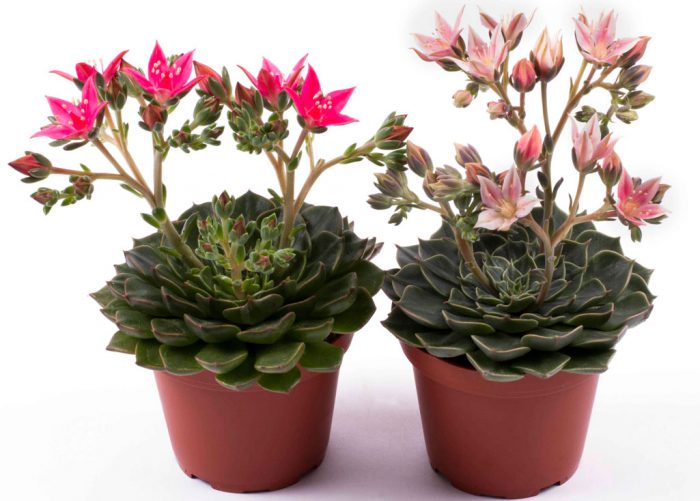
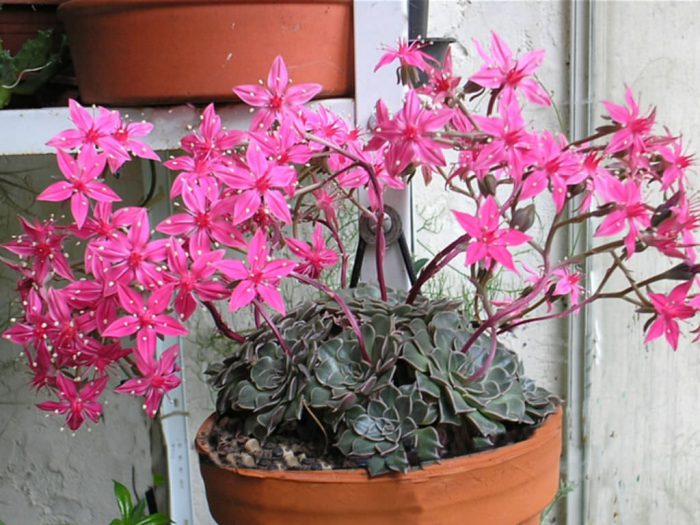


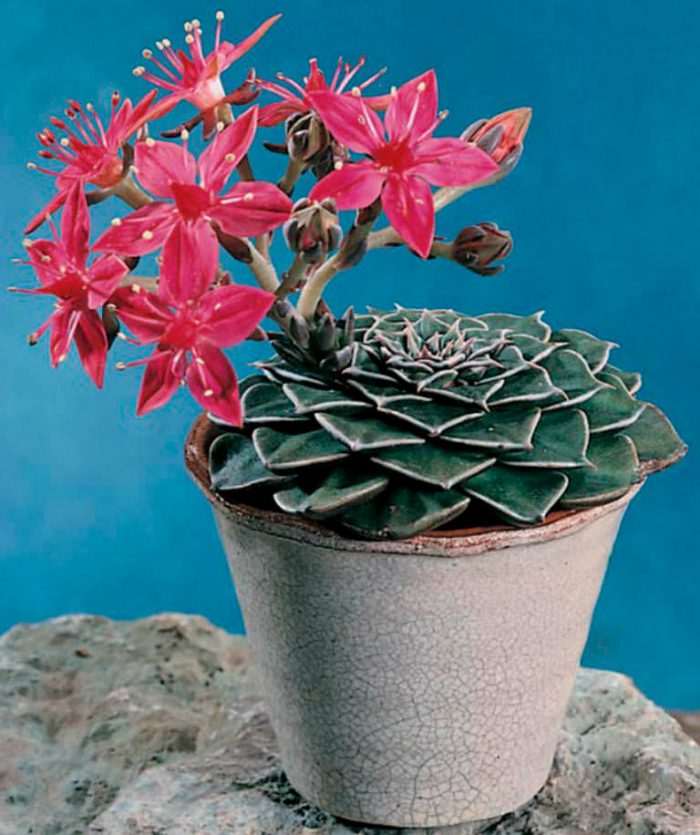
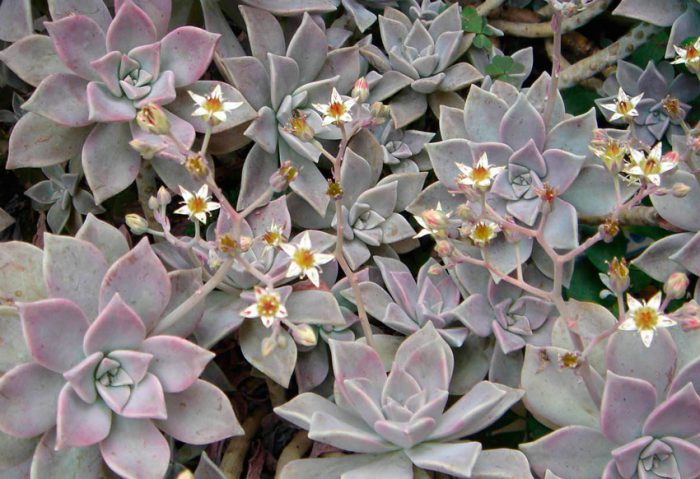
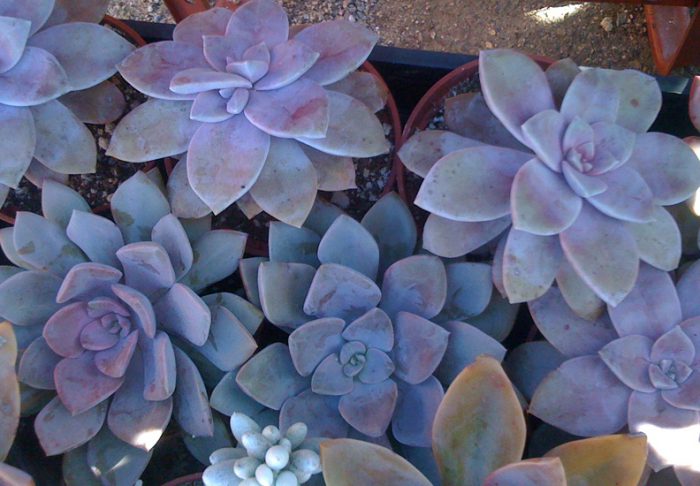



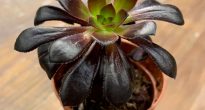

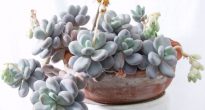
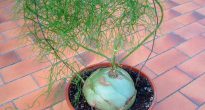
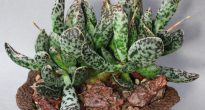
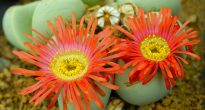

Where do such handsome men sell? In flower shops, you can find one old thing.